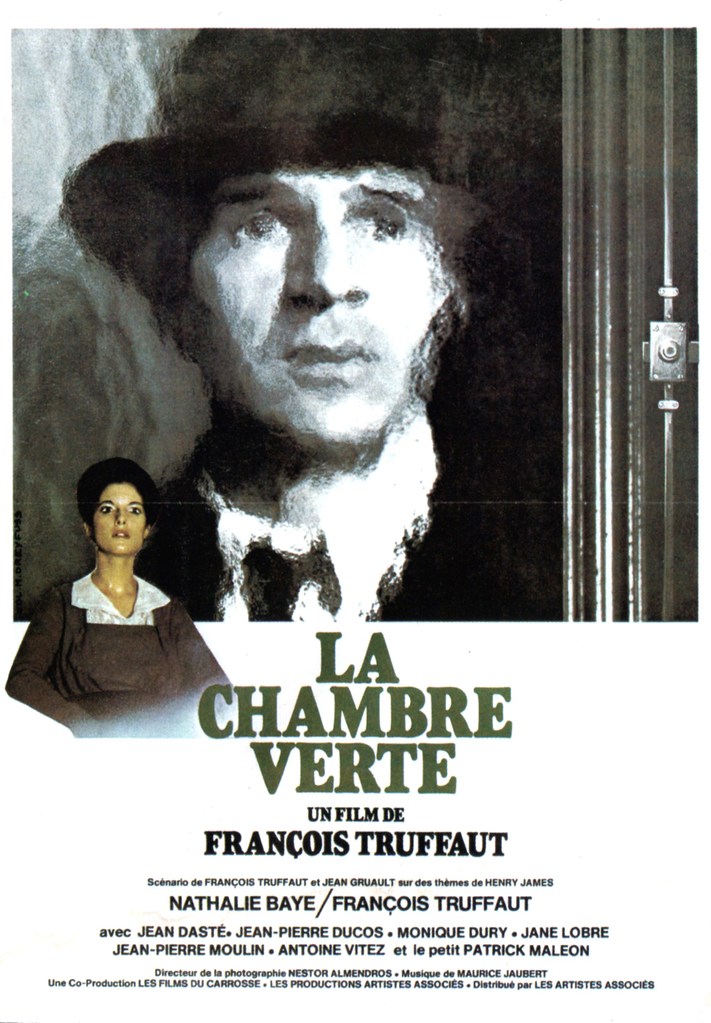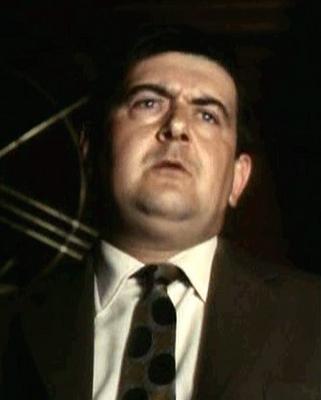Synopsis
Eleven years after the end of World War I, in a small village in the East of France, the journalist Julien Davenne still grieves the death of his beloved wife Julie ten years ago. He worships Julie in a green room in his house decorated with her pictures and belongings. When he meets auctioneer's assistant Cecilia Mandel in an auction house, they see that they have in common the obsession for death and become close to each other. When a fire destroys his green room, Julien convinces the bishop to restore the local chapel and prepare it as a sanctuary for Julie and his dead friends to preserve their memories, while Cecilia falls in love for him, but Julien is dead inside.
Source : IMDb
Credits
Director (1)
Actors (26)
Production and distribution (3)
- Executive Producers : Les Artistes Associés, Les Films du Carrosse
- Film exports/foreign sales : mk2 films
- French distribution : Les Artistes Associés
Full credits (16)
- Screenwriters : Jean Gruault, François Truffaut, Jean-Pierre Moulin
- Director of Photography : Nestor Almendros
- Music Composer : Maurice Jaubert
- Assistant directors : Suzanne Schiffman, Emmanuel Clot
- Editor : Martine Barraqué
- Sound recordists : Michel Laurent, Jean-Louis Ughetto
- Costume designers : Monique Dury, Christian Gasc
- Author of original work : Henry James
- Producer : François Truffaut
- Assistant Operators : Florent Bazin, Anne Khripounoff
- Camera operator : Dominique Le Rigoleur
- Production manager : Geneviève Lefebvre
- Continuity supervisor : Christine Pellé
- Production Designer : Jean-Pierre Kohut-Svelko
- Art directors : Jean-Louis Poveda, Pierre Gompertz
- Sound mixers : Vincent Arnardi, Jacques Maumont
Watch this movie
Watch The Green Room in VOD
| Platforms | Model | Price | Quality |
|---|
Sorry, your search returned no results.
| Platforms | Model | Price | Quality |
|---|
Sorry, your search returned no results.
| Platforms | Model | Price | Quality |
|---|
Sorry, your search returned no results.
| Platforms | Model | Price | Quality |
|---|
Sorry, your search returned no results.
Technical details
- Type : Feature film
- Genres : Fiction
- Sub-genre : Drama
- Themes : Death
- Production language : French
- Production country : France
- Original French-language productions : Yes
- Nationality : 100% French (France)
- Production year : 1978
- French release : 05/04/1978
- Runtime : 1 h 34 min
- Current status : Released
- Visa number : 43535
- Visa issue date : 15/03/1978
- Approval : Yes
- Production formats : 35mm
- Color type : Color
- Aspect ratio : 1.66
- Audio format : Mono
Box-office & releases
Box Office
This content is for registered users only.
Are you a member? Please login to view content.
International releases
| Country | Distributor | Buyer | Release date | Titre local |
|---|
Sorry, your search returned no results.
TV broadcasting
This content is for registered users only.
Are you a member? Please login to view content.
News & awards
Selections (2)
About
Background and writing
Truffaut first began work on The Green Room in December 1970 when he began reading the works of Henry James after a painful breakup with actress Catherine Deneuve. Truffaut especially liked The Altar of the Dead and asked his friend Aimée Alexandre to translate a new French version for him to read. Alexandre also recommended works by Anton Chekov and Leo Tolstoy that had similar themes to the James short story, while Truffaut did his own research on James's life and even visited the author's home in Boston. Truffaut worked on other projects until 1974 when a new French version of the short story was published and renewed his interest in the project. He asked screenwriter Jean Gruault to write a draft of the script in July 1974.
Over the years Truffaut had become increasingly interested in people from his life ho had died, beginning with his mentor and father-figure André Bazin, who had died the day before Truffaut began shooting his first feature The 400 Blows. Truffaut told a reporter "I'm faithful to the dead, I live with them. I'm forty-five and already surrounded by dead people." In 1977 Truffaut also lost two other important father figures: Cinémathèque Française director Henri Langlois and Roberto Rossellini, whom Truffaut called "the most intelligent man, along with André Bazin. Around this time period Truffaut had watched his film Shoot the Piano Player for the first time in many years and noticed that half the actors had died since the film was made. In an interview with L'Express magazine Truffut asked "Why not have the same range of feelings for the dead as for the living, the same aggressive or affectionate relationship?" and added that he wanted to film "what it would be like to show on screen a man who refuses to forget the dead."
Truffaut and Gruault continued to work on the script and Truffaut recommended that Gruault read James's "The Beast in the Jungle" and "The Way It Came", which also became incorporated into the film. Truffaut also knew that he wanted to change the setting of the original story to France in the 1920s and have World War I be a major factor in the plot. By the spring on 975 Gruault had finished a first draft called "La Fiancée disparue" ("The Vanished Fiancée"). Truffaut thought the cript wa too long and Gruault made cuts but was becoming dissatisfied with working with Truffaut, along with being busy writing the script for Alain Resnais's Mon oncle d'Amérique. Truffaut put the entire project on hold and eventually shot Small Change and The Man Who Loved Women. However he continued to research the themes of The Green Room, re-reading Marcel Proust's "In Search of Lost Time" and Japanese literature such as the works of Jun'ichirō Tanizaki. He also asked Éric Rohmer for help with the script, but Rohmer was not interested in the project.
In October 1976 Truffaut showed a new draft to Gruault, which now included a deaf-mute child as the main character Julian Davenne's protégé and had Davenne work as an obituary writer in a small Parisian magazine. Gruault finished a new version of the script by February 1977. Truffaut worked on it with his assistant Suzanne Schiffman and completed the final draft in May 1977.
Casting
For the lead role of Julien Davenne, Truffaut first wanted to cast actor Charles Denner, but Denner was not available. Becaue of the inensly personal nature of the film and the character of Julien Davenne, Truffaut decided to play the part, stating that "this film is like a handwritten letter. If you write by hand, the letter won't be perfect, the handwriting might be a bit shaky, but it will be you, your handwriting." Depite his strong feeling for the character, Truffaut was hesitant about the role and thought he may be precieved as too old. He had a wig made, but ended up not using it. It was Truffaut's third and last of his own film in which he played a leading role. He told a reporter that "it seemed to me that if I played Julien Davenne myself, it would be like writing a letter by hand rather than typing it." According to co-star Natalie Baye Truffaut almost shut the film down altogether due to fear of a bad performance.
Baye was cast as Cécilia after having worked with her in Day for Night and The Man Who Loved Women. Baye later stated that "If Francois asked me to perform with him, it was because he knew I wasn't the kind of actress who caused problems. He could rely on me, which was very reassuring to him." Truffaut filled out the cast with Jean Dasté as Davenne's boss at The Globe, Antoine Vitez as a clergyman, Jean-Pierre Moulin as a widower that Davenne confronts in the film and Patrick Maléon as the deaf-mute child. Truffaut also cast technicians and personale from his production company in small roles in the film.
Truffaut later told a reporter "Without being a believer, I too — like Julien Davenne — love the dead. I think we forget them too fast, we don't honor them enough. Without going as far as Davenne- who is obsessed, loving the dead more than the living- I find that remembering the dead permits one to struggle against the transcience of life." On the character of Davenne, Truffaut said "ultimately, the notion of communuication is parallel to that of survival. One survives not by himself but thank to others. I think I've never praised solitude in a picture. When I show a loner, I am criticizing him." When asked about what the message of The Green Room was, Truffaut said "I am for the woman and against the amn. As this century approaches its end, people are becoming more stupid and suicidal, and we must fight against this. The Green Room is not a fable, not a psychological picture. The moral is: One must deal with the living! This man has neglected life. Here we have a breakdown of the idea of survival.
(...)
Source : Wikipedia























































